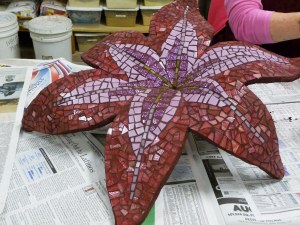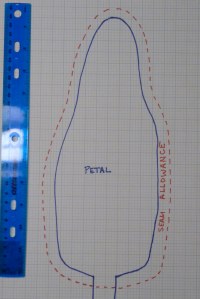Wednesday
Feb222012
Forget the promises and excuses.
 Wednesday, February 22, 2012 at 6:32AM
Wednesday, February 22, 2012 at 6:32AM
Folks, once again, I let circumstances get in the way of writing this blog. So, from now on, no more promises and no excuses. What you get is what you get. So many of you have written to tell me this tutorial makes a difference for you. Thank you for all your kind words and enthusiasm. Please note that what you create inspires me too. I am looking forward to seeing what you make from my notes.
Our topic today is cutting styles. In my last post I mentioned that triangles are a no-no in traditional mosaic methods. It is appropriate to use traingles if you are drawn to them, however notice how all the points can converge to a single point that attracts the eye. If you do not intend for the eye to be drawn to that place in your mosaic, then avoid the triangle. I have used triangles in some of my works, especially when in a hurry to fill something in (see pink flamingo). I find the style reminds me of taking the easy way out and as such it is not my favorite. I have seen works by other artists who use triangles as fill areas to great effect. Work this out for yourself as you go along.
 Detailed area showing triangle shapes.
Detailed area showing triangle shapes.
Styles of mosaic workings are referred to as OPUS. There are regulated, patterned OPERA (plural of opus) and random, crazy-styled OPERA. Each working gives the mosaic its ANDAMENTO, the movement or flow of the work.
My examples in the drawing show the talavera design I am working using various opus styles. I've mixed them up as an example only and am afraid it does not read well. For more information on cutting styles, there are many mosaic books out there that illustrate the techniques.

I have decided to make this flower sculpture as an indoor piece using smalti as my material. I carried the armature around with me for weeks looking at it in different positions and settings, even hanging it upside down and considering the possibility of adding lights! After a while, I settled on a simple setting appropriate for display on a table or pedestal.
Play with different opera.
Study the works of other artists you admire.
Study historical mosaics and identify the various opera.
Choose a material or set of materials for your flower. Use only high-fire, frost-proof materials for outdoor works.
Consider whether you will work one side or both of the flower petals. Remember, adding the glass or stone makes the piece heavier and you will need to make certain your petals can sustain the weight of the materials you choose.
Ciao!
Our topic today is cutting styles. In my last post I mentioned that triangles are a no-no in traditional mosaic methods. It is appropriate to use traingles if you are drawn to them, however notice how all the points can converge to a single point that attracts the eye. If you do not intend for the eye to be drawn to that place in your mosaic, then avoid the triangle. I have used triangles in some of my works, especially when in a hurry to fill something in (see pink flamingo). I find the style reminds me of taking the easy way out and as such it is not my favorite. I have seen works by other artists who use triangles as fill areas to great effect. Work this out for yourself as you go along.
 Detailed area showing triangle shapes.
Detailed area showing triangle shapes.Styles of mosaic workings are referred to as OPUS. There are regulated, patterned OPERA (plural of opus) and random, crazy-styled OPERA. Each working gives the mosaic its ANDAMENTO, the movement or flow of the work.
My examples in the drawing show the talavera design I am working using various opus styles. I've mixed them up as an example only and am afraid it does not read well. For more information on cutting styles, there are many mosaic books out there that illustrate the techniques.

I have decided to make this flower sculpture as an indoor piece using smalti as my material. I carried the armature around with me for weeks looking at it in different positions and settings, even hanging it upside down and considering the possibility of adding lights! After a while, I settled on a simple setting appropriate for display on a table or pedestal.
Play with different opera.
Study the works of other artists you admire.
Study historical mosaics and identify the various opera.
Choose a material or set of materials for your flower. Use only high-fire, frost-proof materials for outdoor works.
Consider whether you will work one side or both of the flower petals. Remember, adding the glass or stone makes the piece heavier and you will need to make certain your petals can sustain the weight of the materials you choose.
Ciao!















